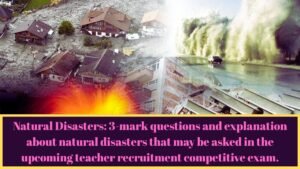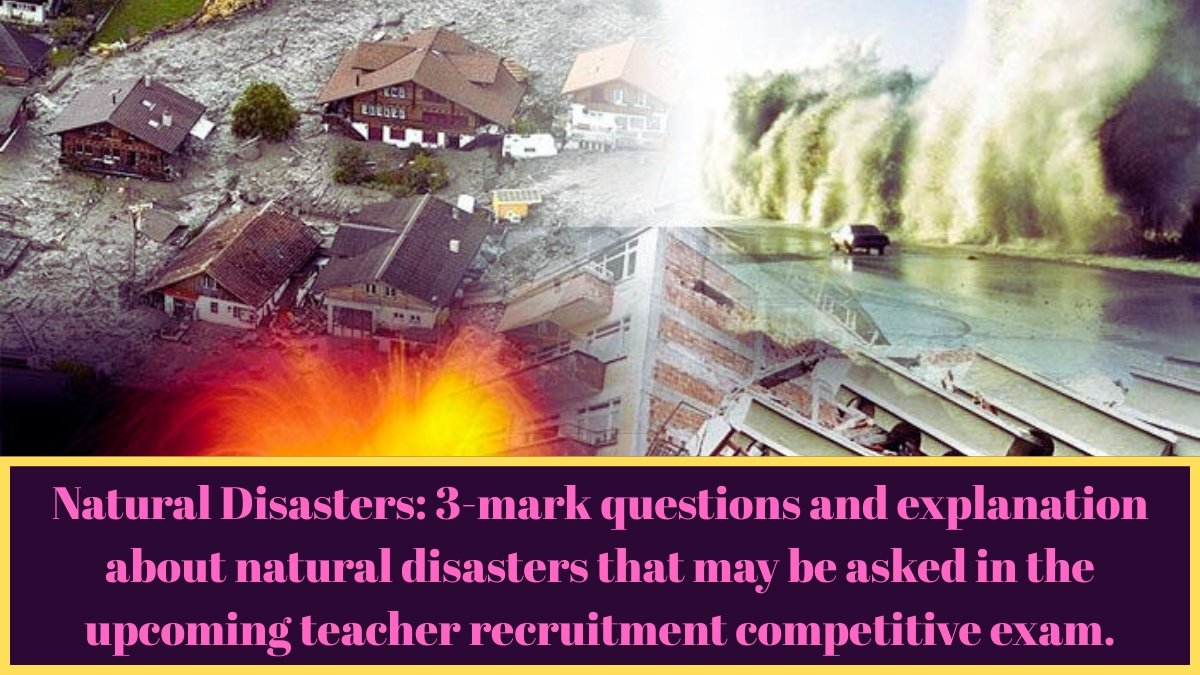Natural Disasters: 3-mark questions and explanation about natural disasters that may be asked in the upcoming teacher recruitment competitive exam.

1. Which one of the following is an unpredictable natural disaster ?
1) Earthquake
2) Cyclone
3) Tornado
4) Hurricane
Ans:- 1) Earthquake
• Earthquakes are natural disasters and destructions caused by intense movements and disturbances in the rocks within the Earth’s interior.
• Earthquakes are caused by movements within the Earth’s interior, due to natural and man-made stresses.
• According to the country’s seismic zone map, India is divided into 4 seismic zones.
• Zone 2:- The least seismically active zone. This zone covers 41% of India’s land area. The Indian Standard Code (IS) has estimated the seismicity factor of this zone as 0.10.
• Zone 3:- Zone of moderate damage risk. Here IS code assigns 0.16 to this zone. Land area covered: 30%.
• Zone 4:- High damage, danger zone, IS code: 0.24, Land 9: 18%
• Zone 5:- This is the zone with the highest risk of damage due to the continentality. IS Code: 0.36, this zone covers 11% of the area of India.
• Note:- The districts of Belgaum, Mangalore, Dharwad, Vijayapura, and Karwar in Karnataka fall under Zone 3.
—————————————————————————
2. An earthquake is also known as
1) Teacher
2) Tremor
3) Temper
4) None of these
Ans:- 2) Tremor
• An earthquake is also called a tremor, tremor, or tremor.
• On Earth, earthquakes are caused by shaking and sometimes by ground displacement.
• This creates seismic waves as a result of the sudden release of energy in the Earth’s crust.
————————————————————————
3. An earthquake of magnitude_on Richter scale has thousand times more destructive energy than an earthquake of magnitude 4.
1) 5
2) 7
3) 6
4) 8
Ans:-3) 6
• The Richter magnitude of an earthquake is determined by the logarithm of the amplitude of the waves recorded by the earthquakes
• Each increase of one unit on the scale represents a 10-fold increase in earthquake intensity.
• Two points of 4-6 or 5-7 on the Richter scale correspond to about 1000 times the energy release.
————————————————————————-
4. In the context of plate tectonics, which of the following statements is NOT correct?
1) Eurasian plate is largely an oceanic plate.
2) The major tectonic plates are surrounded by young fold mountain ridges, trenches, and/or faults.
3) Tectonic plates move horizontally over the asthenosphere.
4) Earth’s surface is divided into seven major plates
Ans:- 1) Eurasian plate is largely an oceanic plate.
• Eurasian Plate
• It is a tectonic plate that covers most of the continent of Eurasia (the landmass that includes the traditional continents of Europe and Asia), the Indian subcontinent, the Arabian subcontinent, and eastern Siberia, except for the area east of the Chersky Range.
• It also includes oceanic crust extending to the Mid-Atlantic Ridge to the west & the Gakkel Ridge to the north.
—————————————————————————
5. _______gases trap heat in the atmos-phere which the Earth warmer, causing global warming.
1) Compound
2) Greenhouse
3) Nobel
4) Elemental
Ans:- 2) Greenhouse
• The greenhouse effect is the process by which heat is trapped near the Earth’s surface by “greenhouse gases”.
• The main greenhouse gases whose concentrations are increasing are carbon dioxide, methane, nitrous oxide, hydrochlorofluorocarbons (HCFCs), hydrofluorocarbons (HFCs), and ozone.
————————————————————————-
6. What is Marble Cancer?
1) Disease in animals due to marble mines
2) Soil degradation due to marble mines
3) Cancer in human due to working in mines
4) Corrosion of marble due to acid rain
Ans:- 4) Corrosion of marble due to acid rain
• Marble cancer refers to the corrosion of buildings and statues made of marble by the action of sulfuric acid and nitric acid.
• When water vapor from the atmosphere reacts with sulfur dioxide and nitrogen dioxide in the air, a compound called sulfuric acid and nitric acid are formed.
• This increases the acidity of rainwater.
• As a result of acid rain destroying marble, the building material is called marble cancer.
————————————————————————-
7. Earthquakes are generally associated with:
1) Joints
2) Faults
3) Folds
4) Schistosity
Ans:- 2) Faults
• An earthquake is a severe shaking or vibration of the Earth’s crust.
• This is a way of transferring kinetic wave energy through the Earth’s crust.
• It is described as a tremor or sustained shaking caused by the sudden movement of rigid rock.
• The place in the Earth’s lithosphere where an earthquake originates is called the ‘earthquake epicenter’ or ‘earthquake epicenter’ or ‘earthquake epicenter’.
• Seismic waves are divided into three types:
• Long waves . transverse waves • Waves above
—————————————————————————
8. How many seismic stations are required to locate the epicentre of an earthquake?
1) 3
2) 4
3) 5
4) 6
Ans:- 1) 3
• The place where actual motion takes place inside the Earth is called the center of gravity.
• The point directly above the center is called the epicenter.
• At least three seismic stations are needed to locate the epicenter of an earthquake.
————————————————————————-
9. Flash floods’ are associated with
1) Thunderstorms
2) Cyclonic storms
3) Tsunami
4) Tornado
Ans:- 2) Cyclonic storms
• Flash flood is the rapid flooding of low-lying areas of landforms.
• A flash flood is a rapid rise of water across a stream or low-lying area of a city.
• Usually caused by severe storms that produce heavy rainfall in a short period of time.
• It can be caused by severe thunderstorms, hurricanes, tropical cyclones or typhoons, or by heavy rain flowing over ice or snow meltwater or snow sheets.
————————————————————————-
10. Tsunamis are cuased by
1) mixing of cold and warm currents
2) earthquakes
3) changes in sea level
4) volcanic eruption
Ans:- 2) earthquakes
• Tsunami (“Tsu” – harbor, “nami” – waves) means harbor waves.
• Tsunamis are a series of very high waves that originate in the oceans.
• Tsunami:- Giant ocean waves that are rarely generated along the coastline of a vast ocean by an earthquake that occurs deep under the water or on the ocean floor are called ‘tsunamis’.
• This sudden movement is a sea wave caused by earthquakes under the sea. It can be caused by a powerful volcanic eruption or an underwater landslide. The impact of a large meteorite can also cause a tsunami.
• This is common in Japan, where they are locally known as ‘harbor waves’.
————————————————————————–
Natural Disasters: 3-mark questions and explanation about natural disasters that may be asked in the upcoming teacher recruitment competitive exam.

11. Which type of lake is formed by volcanic activities?
1) Caldera lake
2) Karst lake
3) Lagoon
4) Fresh water lake
Ans:- 1) Caldera lake
• Volcanic basin refers to a large basin-shaped crater bound by steep cliffs.
• The most famous crater lake in North America is the volcanic crater lake.
• Volcanic crater (Coldera):- A large opening that releases magma from the Earth’s interior when a volcano erupts.
• The diameter of the top of the Krakatoa volcano is about 7 to 8 km. in diameter.
• When there is no activity in these volcanic craters for a long period of time, the space fills with water and eventually turns into a lake.
————————————————————————
12. The cup-shaped mouth of the volcano is
1) Focus
2) Epicentre
3) Crater
4) Cinder cone
Ans:- 3) Crater
• The end where the magma erupts above the ground is called the crater or mouth of a volcano. 1
• The magma that comes out of a volcano solidifies around its mouth. Also, various types of solid materials that are ejected along with the lava accumulate around its mouth. Thus, mountains or peaks are formed by the accumulation of these. These are called volcanic cones.
• For example, Lake Pinatubo, Philippines.
• Formed after the 1991 eruption of Mount Pinatubo.
—————————————————————————–
13. Molten rock below the surface of the earth is called
1) Basalt
2) Laccolith
3) Lava
4) Magma
Ans:- 4) Magma
• Magma is a mixture of molten or semi-molten rock volatiles and solids found below ground.
• When magma erupts from a volcano, the molten rock is called lava.
• When lava cools on Earth and forms a solid structure, it is called igneous rock.
—————————————————————————-
14. The rock that results from solidifi-cation of molten lava from a volcano is an example of which of the following?
1) Igneous Rock
2) Granite Rock
3) Basalt Rock
4) Magnetite
Ans:- 4) Magnetite
• Igneous rocks are formed by the cooling and solidification of magma (or lava).
——————————————————————————
15. Which of the following is considered to be the largest volcano on Earth (in terms of its mass and footprint)?
1) Ojos del Salado
2) Mount Vesuvious
3) Tamu Massif
4) Mauna Kea
Ans:- 3) Tamu Massif
• Tamu Massif is an extinct submarine shield volcano in the northwestern Pacific Ocean. It is considered the largest volcano on Earth by mass and footprint.
• It is located in Shotsrise, 1,600 km east of Japan.
———————————————————————–
16. Volcanic eruptions do not occur in the______
1) Baltic Sea
2) Black Sea
3) Caribbean Sea
4) Caspian Sea
Ans:- 1) Baltic Sea
• No volcanoes occur in the Baltic Sea.
• The Ring of Fire (also known as the Pacific Ring of Fire) is an area around the edge of the Pacific Ocean where many volcanic eruptions and earthquakes occur.
• The Ring of Fire is a horseshoe-shaped belt about 40,000 km (25,000 mi) long and about 500 km (310 mi) wide.
—————————————————————————-
17. Which of the following is called the safety valve of nature’?
1) Earthquake
2) Ozone gas
3) Volcano
4) Rivers
Ans:- 3) Volcano
• Volcanoes are called nature’s safety valves.
• Volcanoes periodically release pressure caused by tectonic activity in the Earth’s crust and lower layers.
• “The eruption of lava from the Earth’s interior, along with rock fragments, steam, gas, and ash, through a vent in the Earth’s mantle is called a volcano.” In this process, solid, liquid, and gaseous materials from the Earth’s interior are forced out to the surface by internal pressure.
—————————————————————————
18. When does Pele’s Tear occur?
1) at the time of earthquake
2) at the time of plate tectonics
3) at the time of volcanic eruption
4) at the time of mountain formation
Ans:- 3) at the time of volcanic eruption
• Pele’s tears are a geological term for small pieces of solidified lava formed when airborne particles of molten material tear into droplets of volcanic glass.
————————————————————————–
19. The rapid sliding of large masses of bed rocks is called:
1) Landslide
2) Earthquake
3) Weathering
4) Mass wasting
Ans:- 1) Landslide
• Landslide is the falling of piles of rocks and debris due to various surface activities such as heavy rain, snow, gravitational force, etc.
• A landslide is the sudden sliding of a large amount of rock under the force of gravity.
—————————————————————————
20. In mountainous areas a natural cause for road blocks is often:
1) road repairs and construction
2) land slides
3) tree felling
4) traffic congestion
Ans:- 2) land slides
• Landslide is the falling of piles of rocks and debris due to various surface activities such as heavy rain, snow, gravitational force, etc.
• A landslide is the sudden sliding of a large amount of rock under the force of gravity. Landslides and erosion are caused by both natural and man-made forces.
—————————————————————————-





